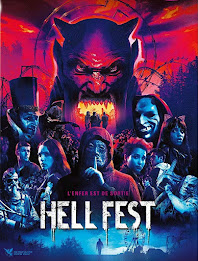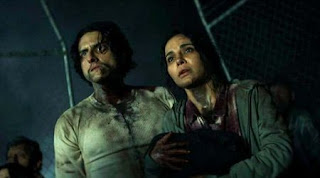Look at me, being timely (for once) with a Halloween-set horror film in October!
Quick Plot: Harper is a college student excited for a Halloween out with friends and far away from her abusive boyfriend. After some loud bar time, her squad heads to a remote haunted attraction, one so extreme that it requires signed waivers and cellphone surrenders.
Obviously, this is not a friendly place. Our staff is composed of members of some kind of violent cult who modify their faces into fleshy masks and murder unsuspecting drunk teenagers with glee. Can Harper and her other blandly (mostly) pretty friends make it out alive? WHO will survive, and what will be left of them?, you might ask.
Made by the writing/directing duo of Scott Beck and Bryan Woods, Haunt is pretty much exactly what you expect from its premise. As with, say, Volcano and Dante's Peak or The Silence and A Quiet Place (the latter also written by Beck and Woods), it's impossible to think about Haunt without comparing it to Hell Fest, the other 2018/19 non-found footage horror film following a group of young college kids through a homicidal Halloween house. The film wasn't overly well-received by critics or the horror community, which surprised me because it was bloody, quick, and genuinely fun.
Haunt is a lesser Hell Fest.
It's not bad by any means, and for me, much more enjoyable than some other recent homicidal haunt films (The Houses October Built and Hell House LLC). But...I don't know. It's fine? Katie Stevens is a sympathetic final girl and Harper's backstory of abuse adds some weight to her character, but I just didn't get that much out of its scares.
If you're going to place your horror film in a setting that's supposed to be the scariest experience its characters can have, I guess I just expect more from you? In my least expressive teacher voice, I feel like my real summation is simply, "I'm not mad, just a little disappointed."
High Points
While I didn't find Haunt's horror segments overly effective, there is certainly some skill at work. I'm a sucker for the "it's coming eventually" trick, and Haunt has some good fun drawing out a "stick your arm in a hole" gag that goes on just long enough to make you inch up on your chair
Low Points
I get that it can easily happen, and I understand that it's an effective genre move, but I can't say it in my Low Points enough: having your beleaguered heroine accidentally kill (and oddly enough, almost always stab) her friend thinking it's her stalker is a mean, nasty trick, and I've been over it for 20 years
Lessons Learned
Just because you planted your own haunt traps doesn't mean you're immune to their tricks
Criminal psychologists know all about 2-way mirrors
In any group of attractive college students, there will inevitably be one prankster who deserves to die
Rent/Bury/Buy
Haunt is a perfectly fine horror film, especially for the Halloween season. For whatever reason, it just didn't do much for me (compared to the incredibly fun time I had with Hell Fest). See if works better for you on Shudder!












































